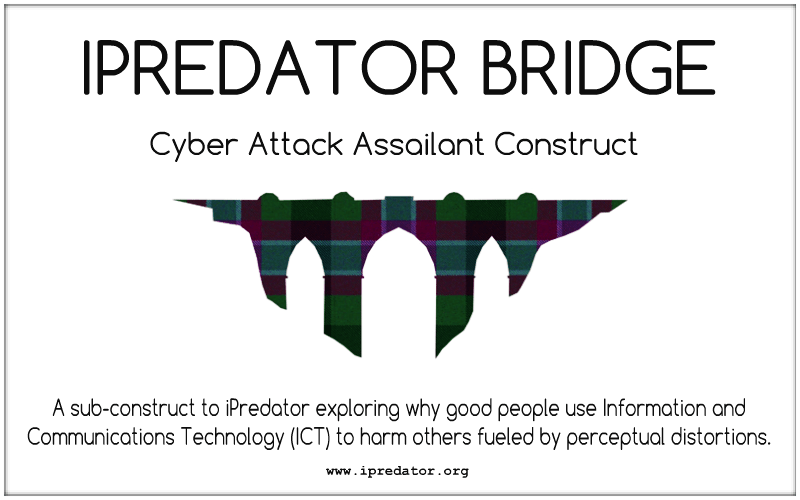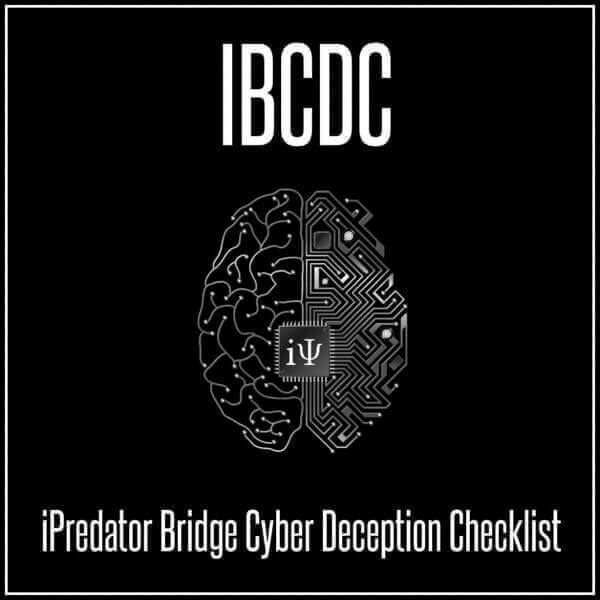
Cyber Deception Checklist (IBCDC)
50 Online Deception Warnings
iPredator Bridge Cyber Deception Checklist (IBCDC): Based on the iPredator Bridge construct, the IBCDC is a 50-item checklist designed to investigate if a loved one, colleague or peer is participating in or close to participating in deception and harmful online activities towards others.
Multiple affirmative responses to IBCDC statements suggests the person being queried exhibits patterned and/or observable behavioral patterns indicating they may be engaged in deception themed iPredator activities. The IBCDC focuses on confirmed behavioral observations and not upon personal convictions and/or philosophical reasons for harming others online or using ICT.
Based on iPredator Bridge construct, the IBCDC assumes there are people engaged in online deception, malevolent activities and those engaged in harming others driven by distorted beliefs they are doing so for righteous and/or morally supported reasons. The common thread identical in both segments are the victims they target suffer from their attacks.
The IBCDC has not been validated by clinical research, a governing body or academic institution. It has been compiled and published to be a point of reference to educate and assist anyone who is concerned that they, their children, business or community are in the presence of an iPredator or someone in transit to becoming an iPredator.
What is Online Deception
Online Deception [aka, Digital Deception, Internet Deception, Cyber Deception] is the use of Information and Communications Technology to deceive other online users usually rooted in malevolent, nefarious or covert online activities. Although primarily used for anti-social purposes, online deception tactics are occasionally designed for benevolent purposes, such as, when law enforcement design felonious profiles of children used to locate, identify and arrest online sexual predators. The art & science of online deception is used by all iPredator typologies including cyberbullies, cyberstalkers, cybercriminals, cyber terrorist, cyber harassers, internet trolls and online sexual predators. Most online users engage in both deception offline and deception online. It is part of the human condition.

What is iPredator Bridge
iPredator Bridge: iPredator Bridge is a theoretical tenet of iPredator representing the psychological, perceptual & behavioral trajectory of people who use Information and Communications Technology (ICT) to harm others. Like the iPredator, they are motivated by personal convictions, greed, power, control, narcissism or psychopathology.
Different from the iPredator, they have yet to fully engage in criminal/deviant activities using ICT or use complex perceptual distortions to validate the harm they cause. iPredator Bridge investigates why some people draw near to this nefarious realm and either proceed in their maladaptive trajectory or cease and desist.
Hidden in cyberspace, and through ICT, they contemplate the benefits and detriments, proceed, and then continue a path where their cognitive and perceptual processes are focused upon directly or indirectly harming others. For those who cross this proverbial bridge, they enter a world where their choices are increasingly governed by criminal, deviant, immoral and maladaptive processes.
Given this writer’s strong belief that there are neurochemical, neuropsychological, perceptual and dissociative based changes occurring in all humans who access and interact with ICT and cyberspace, the compilation of all these factors leads to both a new breed of assailant and victim.
iPredator Bridge is the connection between the dark aspects of the human mind, ICT, cyberspace and activation of direct or indirect harm towards others. The victim or target of an iPredator may or may not have previously engaged the iPredator Bridge construct themselves, and for that matter, may not even know that their loved ones, peers, associates or new online contacts are posturing to become iPredators or actively engaging in iPredator attacks.
There is a plethora of contributing factors influencing people to become iPredators. There are also a multitude of factors that influence some people to approach and cross the iPredator Bridge. And unfortunately, there are a variety of constituents that influence some to be unwilling to institute the necessary practices and safety measures to reduce their probability of becoming a target or victim. The harsh reality is that the wonderful abstract universe of cyberspace and the ICT used to enter cyberspace does not come with directions or blueprints on how to prevent being attacked, disparaged or harmed by iPredators.
Based on this writer’s research and extensive investigation leading to the creation of the iPredator construct, he has compiled a checklist of warning signs that may suggest a person being queried is approaching the iPredator Bridge, in transit or has fully crossed to the realm of iPredator. The iPredator Bridge Cyber Deception Checklist (IBCDC) has not been validated by clinical research, a governing body or academic institution. It has been compiled and published to be a point of reference to educate and assist anyone who is concerned that they, their children, business or community are in the presence of an iPredator or someone in transit to becoming an iPredator.
Online Deception Risk Assessment Tool
Note: Responding “Yes, I Agree, True” to any of the statements does not confirm the person being queried is an iPredator or close to becoming one.
Please be mindful that iPredators use many forums in cyberspace and numerous ICT tools to victimize their targets. In the IBCDC, the term “habitual” represents regular usage of ICT and the Internet. Also in the IBCDC, the acronym, ICT, is defined as Information and Communications Technology and represents an umbrella term consisting of all forms of telecommunication, information technology, broadcast media, audio and video processing, transmission and network-based control and monitoring functions.
As stated above, responding “Yes, I Agree, True” to any of the statements does not confirm the person is an iPredator or close to becoming one. However, affirmative responses to five or more of the statements are a strong indicator that the person being queried is either an iPredator, crossing the iPredator Bridge or suffering from some psychological and/or perceptual dysfunction.

IPREDATOR BRIDGE CYBER DECEPTION CHECKLIST
[IBCDC]
- 1. The person is a habitual social networking site and/or ICT user and regularly interacts with a select group of online contacts that he/she has never met in person.
- 2. The person is a habitual social networking site and/or ICT user and has developed private codes or lingo, which is regularly communicated to a select group of followers.
- 3. The person is a habitual social networking site and/or ICT user and has been confirmed posting information that they quickly delete for no apparent reason.
- 4. The person is a habitual social networking site and/or ICT user and has been confirmed posting information that would be considered cryptic or jumbled in content.
- 5. The person is a habitual social networking site and/or ICT user and has been confirmed posting information about other people’s offline activities that are innocuous or trivial in nature.
- 6. The person is a habitual social networking site and/or ICT user and has been confirmed to publicly post information that excludes someone from being invited to a social activity.
- 7. The person has been confirmed to consistently post information about others in chat rooms, forums or message boards that are trivial and have no social purpose or cause.
- 8. The person has been confirmed to maintain a blog or online public journal that has a central theme with minimal social or creative cause merit.
- 9. The person is a habitual social networking site and/or ICT user and has been confirmed posting images or videos about other people’s offline activities and lifestyle.
- 10. The person is a habitual social networking site and/or ICT user and has been confirmed posting messages, images or videos of other people’s loved ones not known to the person (i.e. husband wife, children, business, etc.).
- 11. The person is a habitual social networking site and/or ICT user and has been confirmed to maintain his/her identity completely private yet seems to spend an inordinate amount of time online and/or using their ICT.
- 12. The person maintains a public live journal, blog or website with a central theme not based in any social cause, intellectual or creative endeavor.
- 13. The person is a habitual social networking site and/or ICT user and has been confirmed posting information about other people’s offline lives that are considered sensitive or private.
- 14. The person is a habitual social networking site and/or ICT user and has been confirmed to impersonate others and engage with others or post information using their felonious identity.
- 15. The person is a habitual social networking site and/or ICT user and has been suspected of spending more time online or using their ICT than with family, friends, loved ones or peers.
- 16. The person is a habitual social networking site and/or ICT user and has been confirmed encouraging online and offline contacts to invest time or money in unsubstantiated ventures.
- 17. The person is a habitual social networking site and/or ICT user and has been confirmed disseminating information that is felonious about their career, expertise or academic/professional achievements.
- 18. The person is a habitual social networking site and/or ICT user and has been confirmed having multiple usernames with different profile descriptions not explained by internet safety practices.
- 19. The person had been observed turning off, shutting down or closing their ICT when a person unexpectedly approaches them.
- 20. The person has been confirmed to frequent websites or social networking sites that have been kept secret, discouraged or forbade by loved ones or family members.
- 21. The person spends copious amounts of time online and/or using their ICT in private without rational reasons.
- 22. The person spends substantial amounts of time online and/or using their ICT researching what others have posted about them or posting information about others.
- 23. The person has been observed or confirmed exaggerating online about erroneous events and events not crucial to their livelihood.
- 24. The person has been suspected or confirmed to be obsessed with religious, political or philosophical societal movements that they express online or using ICT.
- 25. The person has been suspected or confirmed to be obsessed with religious, political or philosophical societal movements and spending time in chat rooms, reading and posting information in forums, message boards and comments themed with their cause.
- 26. The person refuses or is hesitant to disclose or discuss their family, career or any offline information leading to their accurate identification.
- 27. The person has been observed or confirmed using information technologies used to hide their identity or obtain other people’s identity that has not been legally purchased or downloaded.
- 28. The person has been suspected or confirmed contacting others without any apparent reason or obvious connection.
- 29. The person has been suspected or confirmed contacting others multiple times a day.
- 30. The person has been observed or confirmed adding “buddies” or “friends” to their social networking site lists, despite not knowing them.
- 31. The person has been suspected or confirmed encouraging others to move from public forums to private connections such as email, instant messaging or texting.
- 32. The person has been observed or confirmed asking others, online or using ICT, for personal information that has little merit for obtaining.
- 33. The person has been observed or confirmed habitually sending online gifts, badges, likes or +1’s to others they do not know at social networking sites.
- 34. The person has been observed or confirmed expressing, multiple times, how much they like or despise a person, group or organization online or using ICT.
- 35. The person has been observed or confirmed changing their personal information to suit the situation or person they are communicating with.
- 36. The person has been observed or confirmed knowing information about others, but unable or hesitant to disclose how they obtained the information.
- 37. The person has been suspected or confirmed connecting with others online or using ICT across several different platforms (i.e. Twitter, Skype, Email, etc.), despite not knowing their ICT patterns.
- 38. The person has been suspected or confirmed connecting with people’s family, friends or colleagues, despite having no apparent connection to them.
- 39. The person has been observed or confirmed sending or posting disparaging information about others online or using ICT.
- 40. The person has been confirmed having more than 3 or more online relationships involving an adversarial and/or negative outcome.
- 41. The person has been suspected or confirmed retaliating to negative information being spread about them online or using ICT.
- 42. The person has been suspected or confirmed sending embarrassing and/or sensitive information to other people’s mobile devices or phones.
- 43. The person has been suspected or confirmed engaging in “sexting” with others he/she does not know or much younger or much older than they are.
- 44. The person has been suspected or confirmed engaging in sexual conversations with others they have met online or using ICT.
- 45. The person has been suspected or confirmed intermittently spending money at online sex sites.
- 46. The person has been suspected or confirmed regularly responding to contacts from online strangers.
- 47. The person has been suspected or confirmed discussing violent, prejudicial or hate based topics online or using ICT with online contacts or strangers.
- 48. The person has been suspected or confirmed regularly visiting and/or participating in anonymous video or instant messaging chat room sites.
- 49. The person has been suspected or confirmed causing others to log out from chat rooms or instant messaging communicating feeling uncomfortable.
- 50. The person has been observed or confirmed keeping up with news on ICT and/or mobile device security vulnerabilities, despite not having those types of devices.
Michael Nuccitelli, Psy.D.
Michael Nuccitelli, Psy.D. is a NYS licensed psychologist, cyberpsychology researcher and online safety educator. In 2009, Dr. Nuccitelli finalized his dark side of cyberspace concept called iPredator. Since 2010, he has advised those seeking information about cyberbullying, cyberstalking, cybercriminal minds, internet addiction and his Dark Psychology concept. By day Dr. Nuccitelli is a practicing psychologist, clinical supervisor and owner of MN Psychological Services, PLLC. After work and on the weekends, he volunteers helping online users who have been cyber-attacked. Dr. Nuccitelli’s is always available to interested parties and the media at no cost. This website and everything created by Dr. Nuccitelli is educational, free and public domain.

